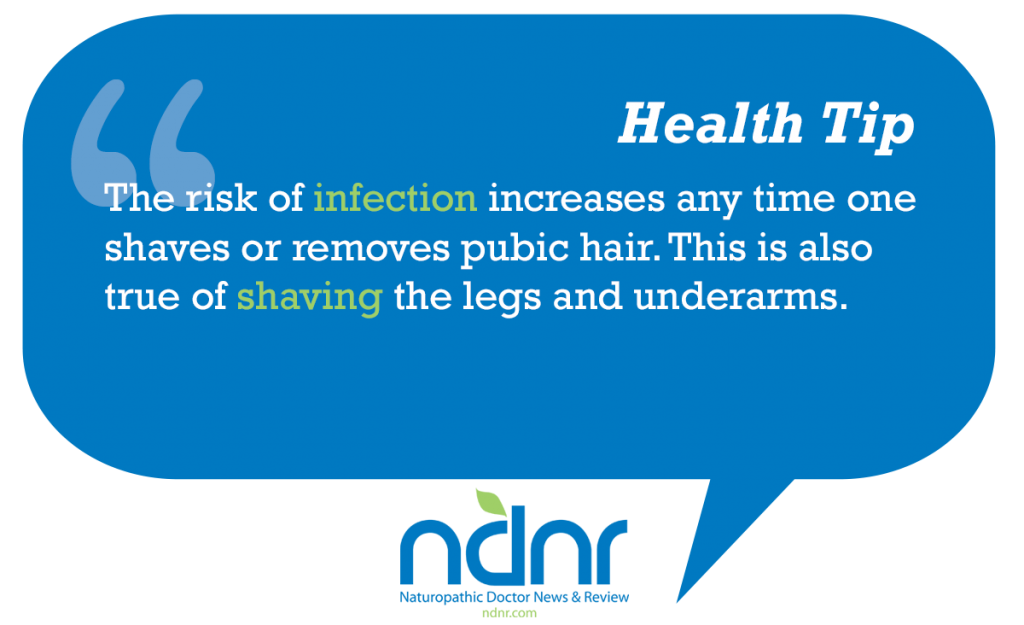Perinatal Pubic Grooming: Health Implications
Mai Heath, ND, BA (Hons), Birth Doula, HBCE
It has been my experience that social norms and societal option are one of the biggest influencing factors on women’s choices for pubic grooming before labor and delivery. That, coupled with shame and embarrassment, can place many women in a quandary about their body image at a time in their lives when their bodies are filling them with awe and confusion.
Pubic hair serves a purpose. It decreases friction, helps protect the skin, affects local temperature, and is intertwined with our dermal microbiome, influencing the balance of helpful and harmful bacteria on our skin. As our skin is our largest immune system organ, pubic hair plays a significant role in our immunity.
The biggest deciding factor on pubic shaving before birth is personal preference, not medical reasoning. As with the decision to shave legs and underarms, the choice to shave before the birth of a baby is largely in the hands of the laboring woman. However, consider the various benefits and risks in order to best inform women and to manage the role of social norms, media, and marketing.1
The Benefits of Pubic Hair Removal
For centuries, removing pubic hair has been used as a treatment for pubic lice. According to one study involving an internet-based survey of nearly 2500 women, total pubic hair removal was associated with a “more positive genital self-image and sexual function.”2 Despite a study in JAMA Surgery claiming that “Preoperative shaving is deleterious, and the practice should be abandoned,” as it may impede wound healing,3 the removal of pubic hair before surgical (cesarean) births in the hospital is more common than not. This removal is to minimize contact with adhesive tape and to clean the area around the incision. Unfortunately, I have heard of nurses or hospital staff, who were assigned to shave women before surgical birth, not being as gentle with this part of the process as the laboring woman would have liked. Therefore, with a scheduled surgical birth, there may be some benefit to shaving oneself, if possible, to optimize control over the situation.
The Risks of Pubic Hair Removal
When women plan to deliver vaginally, regardless of the volume of pubic hair, there is little medical need to shave. “Minor complications commonly occur as a result of pubic hair removal.”4 Risks of pubic hair removal include, infection, ingrown hairs, folliculitis, cyst, injury from cuts, increased incidence of sexually-transmitted infection, skin irritation, and other concerns. It seems that trimming/clipping with sterile scissors poses the lowest risk, followed by hair removal creams, laser hair removal, waxing, shaving with an electric razor, and – lastly – the standard razor, which is involved in most injuries.5
Risk of infection increases any time one shaves or removes pubic hair. This is also true of the legs and underarms. At times, shaving creates tiny cuts that cannot be seen, and may or may not be felt. This causes a breech in the body’s largest immune organ, the skin. Those small breaks in the integrity of the skin make the area more vulnerable to infection. Some of the more prevalent infections associated with pubic shaving include molluscum contagiosum,6 human papillomavirus, genital warts, Staphylococcus aureus, and methicillin-resistant Staphylococcus aureus (aka MRSA).
North York General Hospital, in Toronto, Ontario, cautions women against hair removal past 36 weeks gestation, with their “Do Not Remove The Hair Down There” poster campaign to lower risk of infection with unexpected surgical birth. They go on to say that if the hair is “for some reason…unbearable,” opt for trimming or using hair removal creams. However, due to chemicals, odor, potential irritation from allergy, and lack of evidence that it is safe, I caution against hair removal creams.
If you are overweight or obese, the risk of infection is even greater.4 While being pregnant certainly does not mean you are overweight or obese, studies show that overweight and obese women develop more infection from shaving. This may be due to logistics of shaving, increased area to shave, and more intertriginous areas (areas where skin comes into contact with other skin).
One study showed that there was no clinical difference in outcome between women who shaved before surgical birth and perineal repair, and those who did not.7 Yet, women who shave the pubis often experience irritation, redness, multiple superficial scratches from the razor, and burning and itching of the vulva. Hair regrowth after removal can be irritating and lead to scratches that further disrupt the integrity of the skin. A woman likely does not wish to focus on pubic irritation and infection during her labor and delivery, nor during her postpartum period as she gets to know her baby.
Body Image & Social Trends
It is likely that you know more women than not who remove pubic hair to some degree.8,9 Though pregnancy is a reason why some women take a break from this habit, many women still shave right before delivery because they are embarrassed about what the birth attendants will see. It is concerning to hear women say that they shave out of concern for others. Medical professionals should not be encouraging women to shave or thanking them for doing so. It is in the hands of each healthcare provider to normalize this very healthy part of the body, put women and families at ease, and avoid any off-color jokes. Not doing so likely reinforces an idea that something is inherently unappealing about the female body.8
Body image concerns are often an issue during pregnancy. Removal of pubic hair is most often done for personal body image preference and concern of embarrassment. While mentioned in some medical literature, embarrassment is rarely rated or followed up on. That is unfortunate, because embarrassment is a prominent motivation for shaving, and that data could shed light on social influence.
It is important for women to reflect on the changes during pregnancy and to assess the new relationship with their pregnant body. This is an important aspect of self-care specific to pregnancy. Energetically, women should aim to be as free as possible of any fears or hang-ups before entering the birth room. This is a process. Otherwise, there is potential for inert stress (stress that fails to move one towards a goal) to negatively impact the birth experience.10
Birth Planning
Episiotomy (incision to the perineum to help widen the vaginal opening to birth the baby) will not likely necessitate pubic hair removal. However, for women desiring to deliver vaginally, birth preparation should be focused on having a vaginal birth and a healthy, supported perineum so that surgical births and episiotomies are less likely to be necessary.
There is much we do not know about pregnancy. This is mainly because it is unethical to do testing on pregnant women and unborn children. This is why we often take a conservative “better safe than sorry” approach. I suggest we do the same for pubic grooming. Medical literature, across the board, does not show significant benefit from doing it. While minor to moderate, the risk of infection does increase when pubic hair is removed. It is up to the laboring woman to decide her stance on the risks and benefits. The least risky behavior would be to trim hair with sterile grooming scissors. However, when women decide to shave, they should be encouraged to only do so before 36 weeks gestation so that any resultant infection has more time to resolve before birth.
Summary
More consideration should be given to social pressures and expectations that may encroach on women’s health issues and prey on ignorance. This will be a gradual transition, much like recent social change movements around body-type bias, public breastfeeding, defamation due to presumed promiscuity, etc. Social discussion should focus on the pervasive notion that the vagina is inherently unsightly and unhygienic.
It may come as a surprise to some that the biggest deciding factor on pubic shaving before birth is personal preference and not medical reasoning. Healthcare providers should not implicitly or explicitly send a message to women that pubic shaving will benefit their own health or the health of their babies.
Healthcare professionals should do their part to normalize the presence of pubic hair, create a safe space to discuss grooming and hygiene, and to discourage negative influence from social norms.
 Mai Heath, ND, BA (Hons), Birth Doula, HBCE, is an artist, wife, mother, naturopathic doctor, birth doula, and HypnoBirthing practitioner. She is also the proud recipient of the 2013 Go Natural Inspiration Award, 2011 Gathering Conference Poetry Winner, and the 2010 CytoMatrix Academic Scholarship. She is co-owner of the educational course and private birth plan consultation team, Better Birth Plan. Dr Heath has a special interest in reproductive, perinatal, maternal, and family care. Educating patients to steer their health outcomes is a conviction Dr Heath has developed after working in education. Eagerly sharing in others’ wellness journeys through individualized care and education leads to empowered, inspired communities.
Mai Heath, ND, BA (Hons), Birth Doula, HBCE, is an artist, wife, mother, naturopathic doctor, birth doula, and HypnoBirthing practitioner. She is also the proud recipient of the 2013 Go Natural Inspiration Award, 2011 Gathering Conference Poetry Winner, and the 2010 CytoMatrix Academic Scholarship. She is co-owner of the educational course and private birth plan consultation team, Better Birth Plan. Dr Heath has a special interest in reproductive, perinatal, maternal, and family care. Educating patients to steer their health outcomes is a conviction Dr Heath has developed after working in education. Eagerly sharing in others’ wellness journeys through individualized care and education leads to empowered, inspired communities.
References
- The Sex Information and Education Council of Canada. Check the Research. Female Pubic Hair Removal. April 2012. SIECCAN Web site. http://sexualityandu.ca/uploads/files/CTR_PubicHairRemoval_APR2012-EN.pdf. Accessed November 15, 2015.
- D Herbenick, Schick V, Reece M, et al. Pubic hair removal among women in the United States: prevalence, methods, and characteristics. J Sex Med. 2010;7(10):3322-3330.
- Alexander JW, Fischer JE, Boyajian M, et al. The influence of hair-removal methods on wound infections. Arch Surg. 1983;118(3):347-352.
- DeMaria AL, Flores M, Hirth JM, Berenson AB. Complications related to pubic hair removal. Am J Obstet Gynecol. 2014;210(6):528.e1-e5.
- Glass AS, Bagga AS, Tasian GE, et al. Pubic hair grooming injuries presenting to U.S. emergency departments. Urology. 2012;80(6):1187-1191.
- Desruelles F, Cunningham SA, Dubois D. Pubic hair removal: a risk factor for ‘minor’ STI such as molluscum contagiosum? Sex Transm Infect.2013;89(3):216.
- Basevi V, Lavender T. Routinely shaving women in the area around the vagina on admission to hospital in labour. November 14, 2014. Cochrane Library Web site. http://tinyurl.com/hjfq6b7. Accessed November 15, 2015.
- TiggemannM, Hodgson S. The Hairlessness Norm Extended: Reasons for and Predictors of Women’s Body Hair Removal at Different Body Sites. Sex Roles. 2008;59(11):889-897.
- DeMaria AL, Berenson AB. Prevalence and correlates of pubic hair grooming among low-income Hispanic, Black, and White women. Body Image. 2013;10(2):226-231.
- Newton RW, Webster PA, Binu PS, et al. Psychosocial stress in pregnancy and its relation to the onset of premature labour. Br Med J.1979;2(6187):411-413.










